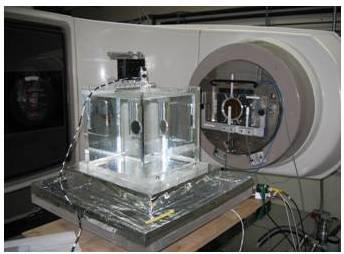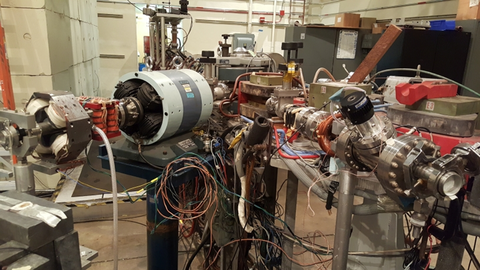Summary
The Radiation Physics Division's accelerator facilities continue to support a broad range of research efforts in the areas of industrial and medical dosimetry, homeland security, radiation-hardness testing and materials-effects studies.
Description

Graphite transfer ionization chamber in a water phantom and monitor chambers attached to accelerator head for dose normalization.
The Division's accelerator facilities continue to support a broad range of research efforts in the areas of industrial and medical dosimetry, homeland security, radiation-hardness testing and materials-effects studies. Topics of research during this reporting period included: (1) a broad-energy range calibration of charged-particle spectrometers used in space-flight applications, (2) calibration of a beta spectrometer which will be employed in a fundamental nuclear physics measurement of the neutron lifetime, (3) solar cell performance validation studies at several different electron energies and fluencies, and (4) an international bi-lateral comparison of high-energy photon dose standards jointly conducted with the Bureau International des Poids et Mesures (BIPM).
Many applications, including electron irradiation of solar cells, require that electron fluences be delivered to a group of perhaps 10 or 15 samples, and that the total fluencies given to all the samples matches the target fluencies. To help achieve these two requirements, a variable-speed radiation scanning system was developed which sweeps back and forth under the electron beam, thereby ensuring that all samples receive the same fluencies. This system employs either one or two scanning arms to allow scanning in one or two dimensions, depending on sample size and uniformity requirements. A digital counter tracks the target charge measured by a Faraday cup and compares it to the actual charge at the end of each scan. The scan speed of the subsequent scan is then adjusted based on the ratio of the measured charge to the target charge. In this way, slow variations in accelerator output are compensated, resulting in the measured charge being within a few tenths of a percent of the target charge in most cases.
The Division's Clinac facility was recently employed in a series of bi-lateral comparisons of the NIST and the BIPM absorbed dose-to-water standards for high-energy accelerator photon beams. These comparisons, piloted by the BIPM, involve about 10 National Measurement Institutes (NMIs) which have a primary dose standard and a high-energy photon beam facility. In each case, the BIPM transports and sets up its own equipment at the participating NMI, and measurements are conducted using at least two photon beam qualities available at the accelerator facility of the respective NMI.
For the measurements conducted at NIST, comparisons were performed using 6 MV and 18 MV photon beams, at a maximum dose rate of 2.4 Gy/min. The NIST primary standard for high-energy photon dose is based on a water calorimeter, in which the small radiation-induced temperature rise in a water vessel is sensed by a thermistor and accurately measured by an AC Wheatstone bridge apparatus. Calorimetric techniques are also employed by the BIPM in their realization of high-energy photon dose; however, the BIPM system uses a calorimeter body made of graphite, and the dose conversion from graphite to water is achieved through the use of a transfer standard and Monte Carlo modeling.
These comparisons were motivated by a desire to demonstrate equivalence of high-energy dose standards between each NMI and the BIPM, and by extension, equivalence of the dose standards among the participating NMIs. Since high-energy photon facilities have almost completely replaced 60Co sources for radiotherapy in industrialized nations, NMIs must develop, maintain and validate their high-energy photon standards. This international comparison provides a rigorous quality-assurance test, and adjustments can be made as needed to the technique or measuring apparatus employed by the NMI to ensure proper dissemination of absorbed-dose standards.

The Medical-Industrial Radiation Facility (MIRF) provides high-energy electron beams for fundamental and applied research in radiation physics and chemistry. The MIRF is based on a re-configured rf-powered, traveling-wave electron linac donated by the Radiation Therapy Center of Yale University-New Haven Hospital. The accelerator provides electron energies from 10 MeV to 28 MeV at an instantaneous beam current of up to 35 mA per beam pulse. In addition, bremsstrahlung generated photon beams can be provided using suitable targets. Two additional beam lines have been constructed to expand the capabilities of the accelerator beyond its original radiotherapy purpose. A high-intensity beam line provides dose rates as high as a kilogray per second to suitable targets. High dose applications include polymer curing, radiation sterilization of products, disinfection of wastes, and hardness testing of electronics. A low-intensity beam line is also available for calibration and performance validation of detector systems.

